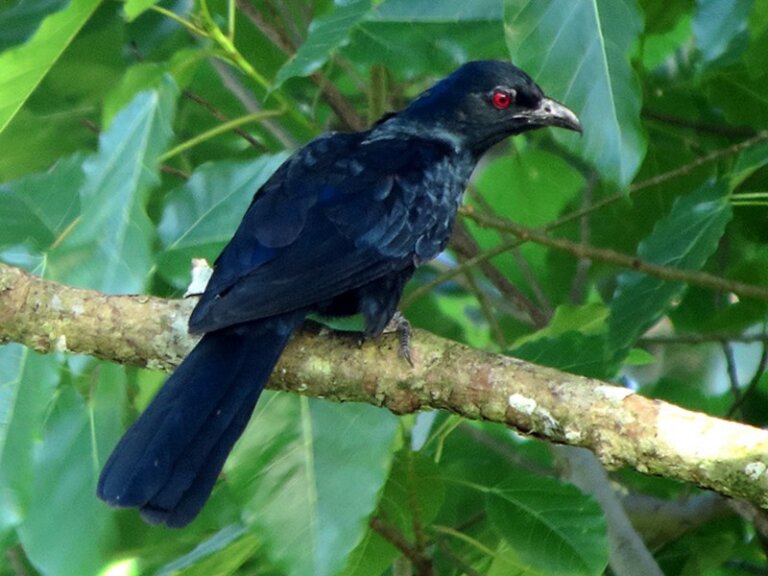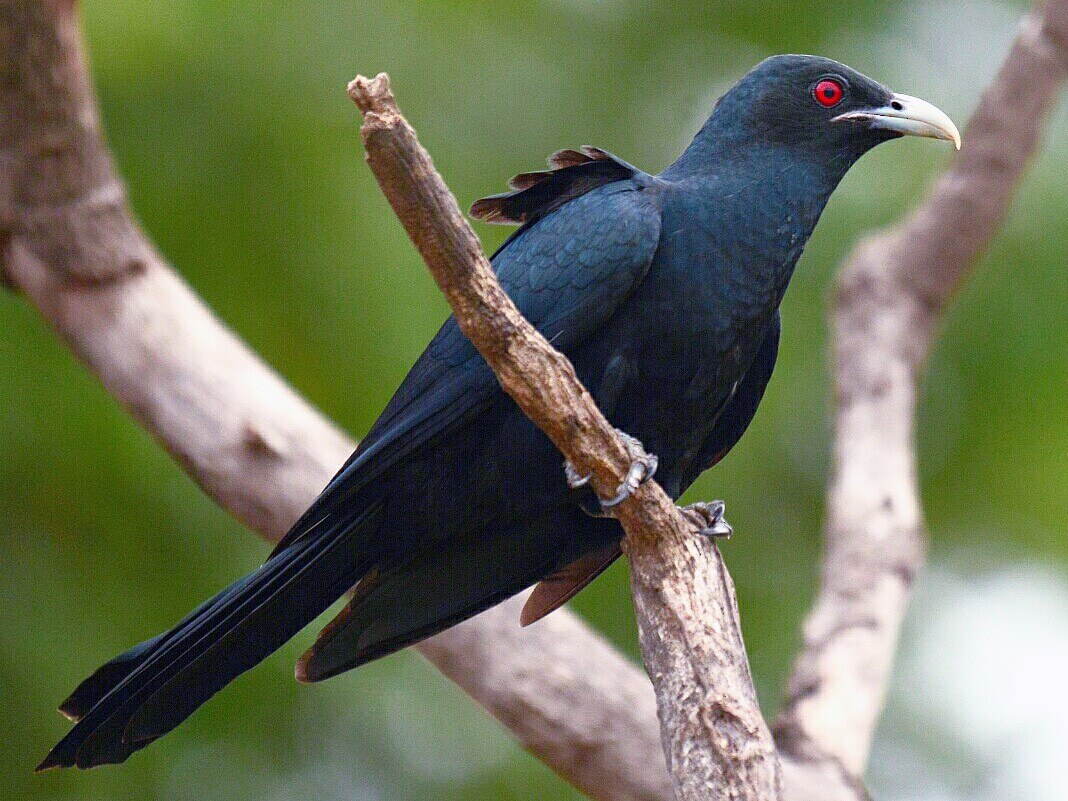The Asian Koel: Characteristics, Habitat and Reproduction

The Asian koel is a very common bird that inhabits South Asia and Australia, known for the characteristic song from which it derives its name (a mix between kik-kik-kik and ko-ooo, depending on sex and population). Although it’s a bit difficult to spot, it’s immediately recognized as soon as it sings.
In addition, its breeding style is one of the most famous in the lands where it lives, as it parasitizes the nests of other birds. For this reason, in this space, you’ll find a complete description of its biological makeup, as this red-eyed feathered bird deserves a lot of attention. If your curiosity has been piqued, don’t stop reading, because you’ll love finding out more about this fascinating bird!
Taxonomy and characteristics
The Asian koel, whose scientific name is Eudynamys scolopaceus, is a bird that belongs to the Cuculiformes order, to which birds such as the cuckoo (Cuculus canorus) also belong. Birds of this order are characterized by their curved and elongated beak, as well as their song and their habit of parasitizing nests.
The Asian koel belongs to the Cuculidae family and to the Eudynamys genus.
The appearance of this bird shows very clearly their sexual dimorphism. Males are completely black, except for some white markings on the edge of the wings, with a beige beak and deep red eyes. The female, on the other hand, exhibits a dark brown plumage mottled with white, with a striped tail.
They’re medium-sized birds, reaching up to 40 centimeters (16 inches) in length and weighing more than 300 grams (just over 10 oz). Young specimens have a plumage more similar to that of the male, but will change to their definitive color with their first adult molt.

Koel habitat
During the cooler parts of the year, the Asian koel resides in southern Asia, in countries such as Iran, Pakistan, India, Bangladesh and Sri Lanka, as well as southern China. In spring, many of these birds migrate to Australia to breed.
It’s during this period that they’re most often heard – the adults calling to find a mate and the young begging for food. They’re very common in suburban areas and in forests with tall trees. It’s easy to see them in crops and light groves, where they find food in abundance and inhabit other birds of similar size that they can parasitize in the breeding season.
Food
The Asian koel is an omnivorous bird that gathers in its diet both fruits and small animals. Their beak has a large opening capacity, so they’re able to consume some whole fruits, as well as bird eggs. Although as chicks they have a mainly insectivorous diet, as adults they feed mainly on fruit.
The Asian koel is an important dispersing agent of sandalwood (Santalum album) seeds, since they regurgitate the seeds of its fruits near them or defecate them far away.
Asian koel behavior
This bird is diurnal and solitary. It only looks for others of its species to procreate during the spring, when some specimens migrate to Australia. Probably its most studied behavior is reproductive. As we’ve said, they’re birds that parasitize the nests of other species to deposit their eggs there and the hosts raise them.
Reproduction
The female usually lays, at most, 2 eggs in the host’s nest. The chicks, unlike other species of the cuckoo family, don’t pull their host siblings out of the nest, but live with them. The biological mother, moreover, occasionally approaches to bring food to her own chicks, a behavior that’s also uncommon, although they may remove eggs from the host to lay their own.
Depending on the area it lives in, the Asian koel will occupy nests of different species similar in size, such as crows, puffins or red wattles.
The young spend an average of 35 days in the nest before fledging and flying for the first time. The breeding season occurs from September to March, during which time the chick will grow to twice its size. If it hatches in a nest of a smaller species, the work of the adoptive parents will be very tiring for them, as the demand for food will be much greater.
Conservation status

At present, this bird is in a state of Least Concern (LC) according to the IUCN. However, its population is considered stable because there isn’t much data on them.
This bird, for a time, was captured from the wild to be caged as a pet, especially in India. The species is also trafficked internationally as an ornamental bird and consumed as food locally. Recently, a study identified several causes of mortality within populations, such as aerial sacculitis, aspergillosis, psittacosis or myocarditis.
Although specific areas where they are known to breed and feed have been protected, there is still much work to be done with the Asian koel, especially in terms of study. So, let’s continue to raise awareness of these overlooked species, which also need help to survive.
All cited sources were thoroughly reviewed by our team to ensure their quality, reliability, currency, and validity. The bibliography of this article was considered reliable and of academic or scientific accuracy.
- Pizzey, G. and Knight, F. 1997. Field Guide to the Birds of Australia. Angus and Robertson, Sydney.
- Strahan, R. (ed) 1996. Finches, Bowerbirds and Other Passerines of Australia.Angus and Robertson and the National Photographic Index of Australian Wildlife, Sydney.
- BirdLife International. 2016. Eudynamys scolopaceus. The IUCN Red List of Threatened Species 2016: e.T22684049A93012559. https://dx.doi.org/10.2305/IUCN.UK.2016-3.RLTS.T22684049A93012559.en. Accessed on 15 December 2022.
- The Australian Museum. (s. f.). Eastern Koel (formerly Common Koel). https://australian.museum/learn/animals/birds/eastern-koel/
- Manjunatha, V., Rout, M., Satish, R., Muniyellappa, H. K., & Byregowda, S. M. (2019). Diagnosis of various pathological conditions causing mortality in Asian koels (Eudynamys Scolopaceus). Indian Journal of Animal Research, 53(10), 1367-1371.
This text is provided for informational purposes only and does not replace consultation with a professional. If in doubt, consult your specialist.